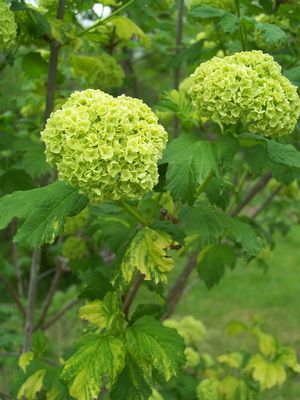View All Plants :: View All DECIDUOUS SHRUBS
Viburnum opulus 'Kristy D.'
European Cranberrybush
Plant Type:
DECIDUOUS SHRUBSViburnum opulus 'Kristy D.' (syn. 'Variegata'; ex: Jonathan Lehrer) - All leaves are irregularly splashed and streaked with sunny yellow; that is, when a branch opts to variegate in a given season - all on the same wood. This is a curious, mercurial plant in that one year there will be little or no variegation apparent while it erupts with lots of variegated leaves in the next season - always a surprise. The golden parts of the foliage age to white. From beguiling and showy bright green buds emerge enlarging light, very bright balls of densely-packed green flowers which mature white. The flowers while developing positively glow and stand in striking contrast to the variegated leaves. Wow! This is one rare and beautiful addition to the exceptional world of viburnums. Taxonomists have tightened the "rules" with plant monikers to eradicate as much as possible confusion relating to similar but different forms. What had been 'Variegata' is now 'Kristy D.' - one and the same. Cutting grown.
Characteristics and Attributes for Viburnum opulus 'Kristy D.'
Season of Interest (Flowering)
- Spring
Season of Interest (Foliage)
- Spring / Summer / Autumn
Autumn Interest
- Fruit / Berries / Seed Heads
- Autumn Leaf Color
Nature Attraction
- Songbirds
- Deer Resistant
- Honey Bees & Native Bees
Light
- Full Sun
- Mostly Sunny
Attributes
- Specimen
- Wildlife Garden
- Shrub Border
- Hedgerow
Growth Rate in the Garden
- Medium
Soil
- Fertile
Origins
- Garden Origin
Propagated By
- Cutting Grown
Genus Overview: Viburnum
Common Name: Viburnum
Viburnum. This genus is full of fantastic, multi-season garden worthy shrubs. Garden heroes. Spring flowers, often large and showy, many with heady sweet fragrance are arranged in cymes. Some smell of musk (Viburnum dilatatum) while others produce no fragrance at all. Flowers are followed with berries. If late season and autumn berries are desired then planting two of a species will ensure fruit set; for instance, Viburnum dilatatum 'Erie' and V. dilatatum 'Michael Dodge' will pollinate each other and produce fruit. Viburnum cassinoides is closely allied with V. nudum; but if the flowering times do not overlap then there will be no fruit. However, if you plant V. nudum 'Winterthur' in proximity with V. nudum var. angustifolium, 'Longwood', 'Moonshine' or 'Pink Beauty' berries will abound. Another interesting example is V. lantana which crosses with V. burejaeticum and vice versa. Any V. plicatum f. tomentosum selection such as 'Shasta' or 'Shoshoni' will pollinate with all other V. plicatum f. tomentosum selections like 'Copper Ridges or 'Pink Beauty'. But if you were to plant two 'Shasta' side by side with no other V. plicatum f. tomentosum in near proximity then your effort will be fruitless. As with almost all in the universe of plants there are exceptions. There is one viburnum which appears to be self-fruitful, Viburnum setigerum the Tea Viburnum. Another interesting exception to the rule is Viburnum nudum 'Pink Beauty' which is also self-fruitful - a departure from its siblings. And on the other spectrum are two I can think of off-hand that are barren, Viburnum plicatum 'Roseum' and Viburnum plicatum 'Kern's Pink'. Oftentimes, the dwarf viburnums reamin in a juvenile state and do not produce fruit. All Viburnum of any size that do produce fruit are magnificent in the late season garden. And they feed all manner of birds. Larger, denser shrubs provide cover and nesting opportunities. Nearly all Viburnum have terrific autumn foliage colors, too. Viburnums are members of Caprifoliaceae. All prefer part to full sun and fertile soils. All are cutting grown. Many thanks to Gary Ladman of Classic Viburnums who generously set us straight regarding some of the details we had originally incorrectly lauded... ya can't know everything!


